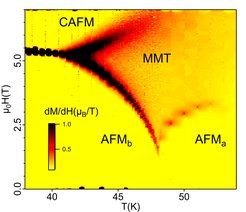Metamagnetic texture in a polar antiferromagnet
Ferromagnetism with parallel arrangement of magnetic moments and antiferromagnetism with an antiparallel one are two textbooks examples of magnetic orders. We report a discovery of a new type of magnetic order realized in Ca3Ru2O7 when a magnetic field is applied along a special direction in a crystal. A coupling between antiferromagnetic and ferromagnetic orders leads to a magnetic texture, which sways from parallel to antiparallel alignment of moments on lengthscales of a few tens of nanometers.
Simple types of magnetic order are easy to visualize: in ferromagnets spins as elementary magnetic moments are parallel and sum up to a finite net moment. In antiferromagnets spins are antiparallel and sum to zero net moment. Nature is much richer and demonstrates more exotic magnetic states, such as spirals, which can be thought of as twisted ferromagnets with nonetheless zero net magnetization.
We have observed a novel type of a spiral magnetic order arising from a simple antiferromagnetic state. In crystals of Ca3Ru2O7, the Ru ions carry antiparallel magnetic moments without applied field. However, the crystal structure of this material breaks the spatial parity. Therefore, hidden couplings exist between the magnetic moments, which can twist them into spiralling arrangements. A magnetic field applied along a special crystal direction, the polar axis of Ca3Ru2O7, reveals the presence of these chiral couplings. The competition between the simple antiferromagnetic state and the ferromagnetic configuration of spins favoured by the field is resolved in an unusual way. At a certain threshold field an interwoven magnetic structure could be observed, where the moments oscillate in space between antiferromagnetic and ferromagnetic configurations over lengths of a few tens of nanometers. We call this state a metamagnetic texture.
Via small-angle neutron scattering measurements we showed directly how this texture forms in Ca3Ru2O7. A competition between ferro- and antiferromagnetism is revealed through strong field and temperature dependence of the length scale of the texture. A complex nature of this modulated state also manifests itself in measurements of the Hall effect, which showed that the electrons traversing the texture acquired an additional phase.
Although magnetic textures in crystals with broken spatial parity were predicted to occur by Dzyaloshinskii more than 50 years ago, experimental findings of such exotic states are still rare. However, research on textured states has become a major field in condensed matter physics since the theoretical prediction and experimental realization of multidimensional textures, now known as chiral skyrmions, in certain ferromagnetic helimagnets. The detected modulation mediating between ferromagnetism and antiferromagnetism provides a novel and much richer type of a texture, as it reconciles two different pure configurations, resulting in one spiral phase. The principles underlying the discovered metamagnetic texture are simple. It is only necessary that broken spatial parity allows for twisting couplings, and that it is possible to tune a system to a point of coexistence, where two different pure phases can co-exist. In a metamagnet, a magnetic field is used to reach the co-existence point of ferro-and antiferromagnetism. The discovery of this metamagnetic texture suggests that similarly, complex spiralling or even multidimensional textures can exist in other condensed matter systems beyond magnetic solids as well, and symmetry considerations can help find them.
This work is a result of international collaboration of scientists from Germany (Max-Planck-Institute for Chemical Physics of Solids and Leibnitz Institute for Solid State and Materials Research, Dresden); National Institute for Materials Science, Japan; Institute Laue-Langevin, and Univ. Grenoble Alpes, France; Paul Scherrer Institute, Switzerland; and the National Institute of Standards and Technology, USA.
More details can be found at https://doi.org/10.1038/s41567-019-0501-0.

